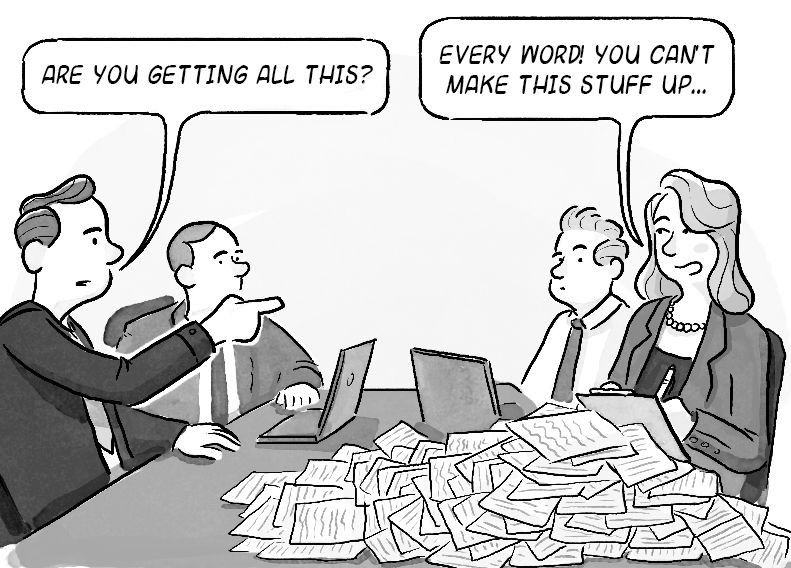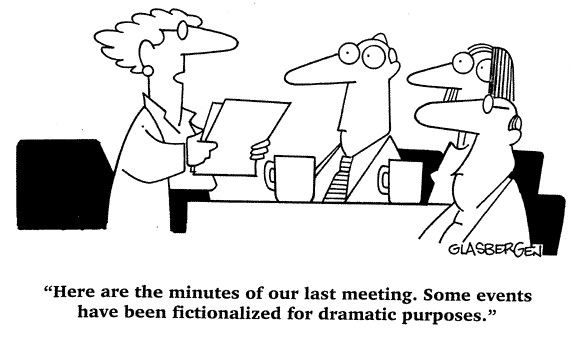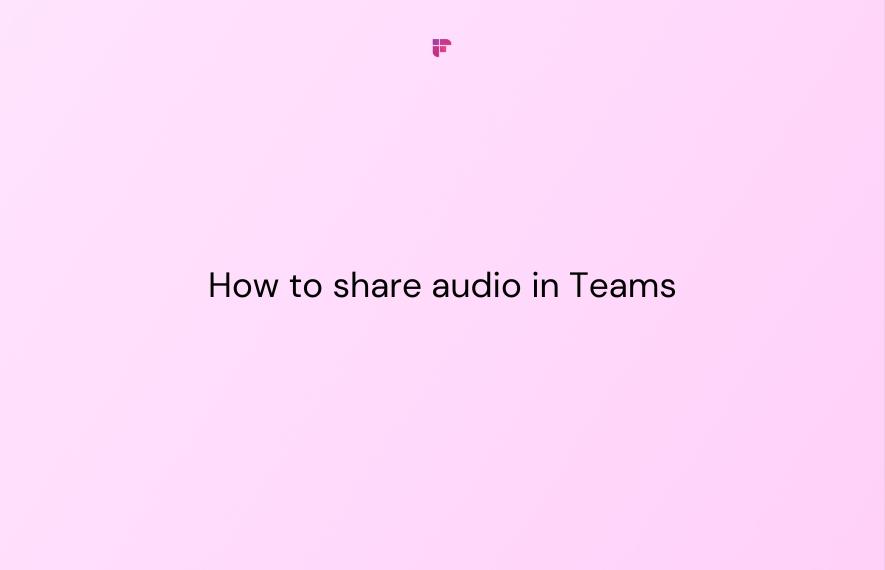Want meetings to be more productive? Well, effective note-taking for meeting minutes could dramatically help.
Taking effective minutes of the meeting is a process, and it starts before the meeting begins. Effective note-taking needs the right planning and key focus areas in mind so that even if the discussion strays, your notes don't.
We are used to attending different types of meetings at work, but all of them have one thing in common- as soon as we are done with them, we tend to forget a massive chunk of information that was shared just moments before, even though we might feel like we remember it well.
Hence it is common to revisit the meeting notes later to collect the essential bits and parts. This makes it very important to have efficient minutes or note-taking protocol in every meeting.
It is also an effective way for the companies to record everything discussed and accomplished in an official meeting.
This article will outline some of our favorite tips for meeting minutes.

What Are Meeting Minutes?
Meeting minutes record the actions taken during a meeting, important points discussed, and the inputs from various employees. All this is saved for the sole purpose of revisiting them later.
Minutes capture the purpose of each meeting in an extremely structured and easy-to-grasp manner.
Multiple professionals work in a company, and most of them have their plates full of the day’s tasks. It is impossible for anyone to take mental notes of official things, including all the actions and decisions with precision. This is where meeting minutes shine as they are super important to keep the essential bits of information safe and look back for any future reference or a follow-up.
Why Are Meeting Minutes Important?
Although it seems like taking minutes of the meeting can take a vast amount of time, in reality, they end up saving time for the business.
For example, if you end up in a situation where you and your colleagues have a different understanding of what was discussed during the meeting, you might need to repeat the meeting if there was no record. So it is better to record it in the form of meeting notes.
Tips for Taking Meetings Minutes Effectively
Taking meeting minutes is not just noting everything down that is being said in a meeting room. Meeting minutes are only effective when recorded correctly and in a style that can be easily referred back, distributed to other people, or quickly understood by anyone just by glancing over it.
To keep your meeting minutes effective and seamless, here are some of the minute-taking tips and techniques.
1. Start With the Essential Details

Start with very basic details of the meeting to give it a structure and an overview that can clear out many questions quickly at one glance.
Also, make sure to include as and when required:
- Date and time of the meeting
- Location of the meeting
- Purpose of the meeting
- Names of attendees and non-attendees who were invited but could not attend
- Agenda Points
These points should be used as a template to record more info, giving context inside each point.
2. Use a Standard Template

By making a more standardized meeting minutes format, we can create a template for meeting minutes that can be populated in each meeting. Consistency in minutes can be a great time saver when there are huge numbers of notes floating around.
Also, anyone reading the meeting minutes made with a standard meeting minutes format can quickly jump to a specific section without wondering where it is written because of the standard and easy-to-use template.
For making a good standard meeting minute format, write down the bare essentials that need to be recorded, and as the requirement increases, keep adding some more points. It should not be very complex but short, to the point, and concise.
3. Write Meeting Minutes While You Still Remember Them

There are several new tips for taking meeting minutes that you can explore, but the art of how to take meeting minutes effectively lies in the basics.
This one is a no-brainer. We all have limited capacity to remember information, and while juggling through a lot of meetings, it is obvious to start gradually forgetting some bits of information.
It is best to write meeting minutes as the meeting happens rather than waiting for the conversation to get over or for someone to take a pause. For writing minutes, you can use any online document editor or a note-taking app. Fireflies is one such app that allows you to get rid of the traditional method of note-taking.
4. State Just The Facts When Taking Meeting Minutes

It is the note-taking person’s responsibility to understand the difference between someone’s opinion and a fact.
Sticking to facts not only helps in stable growth but keeps professional clashes at bay.
5. Record Actions and Owners
During meetings, a lot of actions are taken, and tasks are delegated to the people. Note down all the actions and the people these tasks are assigned to.
Minutes should also contain all the deadlines and previously accomplished tasks that need to be used for review in future meetings.
6. Include Images In Your Meeting Minutes
In meetings, a lot of stuff is drawn on boards for easy explanation and discussion. Take a snap of it and insert them into documents. Other people will love it as they can get a highly accurate context of the meeting discussion.
Photos are great at explaining what was precisely discussed compared to you trying to explain the same in words.
7. Listen More, Summarize Later
Listening more at the meeting is crucial to understand what is being said and precisely in which context. If you keep writing as someone is speaking, it can make things unclear.
Try to listen clearly and openly to all the discussion and summarize it later if required or wait until someone ends their point. This and other meeting etiquettes should be followed in every meeting, be it online or offline.
💡 Fireflies Tip
Tired of taking notes manually? Get your own personal AI assistant and transcribe, store, or even create bite sized notes from any online meeting, with Fireflies!
8. Remain Neutral
Meeting minutes should not include biases regarding specific people or what ‘he said, she said’ conversation.
Minutes should reflect on the meeting without any biases towards any employee or a particular conversation. Do not add any unnecessary details and keep it professional.
9. Be Ready and Organized Before the Meeting Starts
Make sure whoever is assigned to take meeting minutes is ready before the meeting commences.
They should be aware and well-versed in all the tools or software, or devices they would need to record or highlight key points during the meeting. This is one of the most important ways of increasing meeting productivity.
This will make the person more efficient with better productivity and cause no delay during the meeting. All the protocols of recording and organizing should be decided in advance.
10. Summarize
During the meeting, you might write all that you hear as important. But at the end of it, you should present a concise and clear summary of the meeting, and it works well to provide an overview of critical decisions and actions taken during the meeting.
11. Proofread Your Meeting Minutes
Before sending the meeting minutes to everyone, they should be proofread by different people to make sure everything is correct and the language used in the notes is in the right tone. These notes are critical from an organization's point of view. They must not contain any errors, be they linguistic or factual.
12. Send The Meeting Minutes Quickly
Ideally, after the meeting, meeting minutes should be sent to people who were not present, people in important decision-making positions, and the people who might benefit from the information discussed. It should be prepared and sent within a few hours.
Taking meetings minutes is highly tedious and is heavily dependent on human intervention, which increases the chances of error and miscommunication. To make the process seamless and error-free, you can find additional tools to enhance the experience.
Last 2 Cents
With these meeting minute-taking tips for beginners, you can get started for a more efficient notes-taking process.
Minute taking is an essential job for any business. You can utilize all the previous minutes to ensure the next meeting is not repeating the same agenda and can be continued from what has been discussed previously. This keeps the business moving in the right direction.










